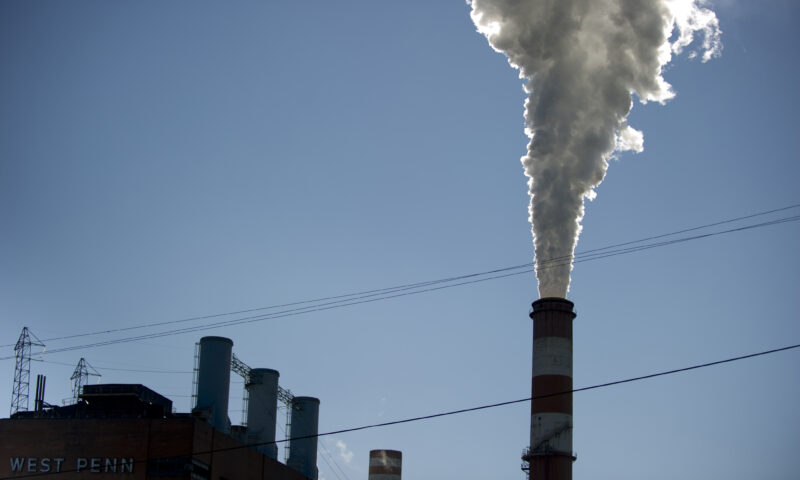Colorado oil and gas companies used toxic chemicals prohibited under state law in operations involving dozens of wells on either side of the Rocky Mountains over at least the last 18 months, a Capital & Main investigation found.
Disclosures to the state’s fossil fuel regulator showed operators combined banned substances with water, sand and other chemicals as part of a process known as hydraulic fracturing, or “fracking.” Companies pump this mixture down a well extending thousands of feet underground to crack shale and release oil and gas.
One of the banned chemicals, known as 1,4-Dioxane, was determined by the U.S. Environmental Protection Agency to present an “unreasonable risk to workers and the general population.” The agency found ingesting or breathing it “can cause cancer, liver toxicity, and adverse effects to nasal tissue.” That substance, and a second also prohibited under state law, 2-Butoxyethanol, are used in fracking fluid. A third, FD&C Blue No. 1, was found by companies and state regulators to have been erroneously listed on disclosure forms.
Colorado’s Energy & Carbon Management Commission, or ECMC, issued notices of alleged violation to 10 companies for using such substances over the prior two months. This story’s findings are based on such publicly available notices, which were analyzed by Capital & Main and researchers with Open-FF and the FracTracker Alliance.
To comply with the notices, which are legally enforceable actions, companies must submit plans to regulators that show how they will “prevent the use of prohibited chemical additives” in fracking fluid in the future. Operators must also “provide a detailed analysis” of whether use of these substances caused “adverse impacts to public health”, and conduct an audit of fracking fluids used in wells since Jan. 15, 2021. That’s the date state rules went into effect that prohibited chemical additives in hydraulic fracturing fluid that “pose unique risks to public health and the environment if accidentally spilled or released.”
Capital & Main contacted all 10 companies for a response to the state regulatory action. Ausco Petroleum Inc., Verdad Resources LLC, Bison IV Operating LLC and Petro Operating Company responded that the prohibited chemicals cited in the notice of alleged violation were listed in error on their disclosure forms. PDC Energy Inc., a subsidiary of Chevron, said it “did not use any prohibited chemicals in its fracking fluids.”
Kerr McGee Oil & Gas Onshore LP, a subsidiary of Occidental Petroleum, responded: “When we discovered the use of the chemical, we responded immediately, stopped the operation, discontinued the chemical’s use, and self-reported our discovery to the state. We are working directly with the ECMC on next steps.”
Laramie Energy LLC said it is “doing a lot of testing and research, it is not a chemical that’s added, it’s a potential contaminant of one of the chemical processes,” and that it plans to submit findings of its investigation later this month. GMT Exploration Company LLC, Extraction Oil & Gas Inc. and Fulcrum Energy Operating LLC did not return requests for comment.
Operators disclosed the prohibited chemicals in response to a 2022 Colorado law that requires companies and their vendors to notify state regulators of all chemicals used “downhole” in oil and gas development. The measure is among the first of its kind in the country to seek transparency about such compounds by prohibiting fossil fuel producing firms from obscuring their identity by listing the substances as “trade secrets.”
After a rocky rollout, with many oil and gas operators failing to file disclosures until this past summer — two years after the law went into effect on July 31, 2023 — the accountability measure is producing results. It has “started to open the door to the public seeing the full range of chemicals the industry uses,” said Gary Allison, a contract researcher at the FracTracker Alliance, a nonprofit that analyzes oil and gas data.
“The longer list of chemicals in many ECMC disclosures is an indication the process is starting to work,” added Allison, who founded Open-FF, a project that distills information reported to fracfocus.org, a registry of fracking chemicals used by operators in 27 states.
Colorado’s unique chemical disclosure law is among myriad rules implemented by regulators since the state’s landmark 2019 measure changed the mission of the state’s oil and gas agency from promoting drilling to protecting public health, safety and the environment.
Pressure has been building on officials for more than a decade to tighten regulations on fossil fuel development as drilling moves ever closer to fast-growing suburbs. The state is the nation’s fourth largest oil producer and eighth biggest gas producer.
The chemical disclosure law’s rollout marks a milestone in a years-long campaign by physicians, conservation groups and residents to ensure that energy companies disclose all of the chemicals they use in fracking fluid. Such information is necessary to conduct epidemiological studies of possible associations between rapidly expanding fossil fuel development and chronic public health effects, researchers say. In many cases there is no peer-reviewed data on the toxicity of substances used in fracking.
The Environmental Protection Agency found in a 2016 study on hydraulic fracturing that only 46% of the 1,606 chemicals it considered “have at least some relevant public data available.” In Colorado, chemical disclosures that companies are required to make to a new state system come on top of rules mandating that operators report liquids used on well pads to the FracFocus registry.
The online database, managed by the Ground Water Protection Council, holds tens of thousands of disclosures made by scores of operators since it went live in 2011. Several dozen states from Alaska to Pennsylvania to South Carolina require, or allow, companies that drill within their boundaries to report substances to the registry. In most of these states, operators can list ingredients in FracFocus as “trade secrets,” meaning the identity of the chemicals could be kept confidential. The use of such designations increased as companies fracked more wells in the last decade, propelling the United States to become the world’s largest oil producer.
“We found the mass use of chemicals designated as trade secrets has increased over the study time period from 728 million pounds in 2014 to 2.96 billion pounds in 2022,” wrote Allison, the FracTracker researcher, as co-author of a peer reviewed study published in February 2024 in the Journal of Environmental Management. “A total of 10.4 billion pounds of chemicals were withheld as trade secrets in this time period.”
Health researchers in Colorado had a headstart on chemicals used in fracking after the state was among the first to require operators to disclose chemicals to FracFocus. Even so, it allowed companies to designate substances as trade secrets. But the state’s new chemical disclosure law does away with this loophole, providing an unprecedented look at the slew of toxic compounds operators use to coax oil and gas from deep underground.
A search of the Energy & Carbon Management Commission’s Chemical Disclosures database showed that operators reported using chemicals known as “quaternary ammonium compounds” at 59 locations over the last 15 months. Scientists say that these substances carry higher risks of exposure for children and pregnant women. The list surprised public health researchers.
“I was really shocked,” said Tracey Woodruff, a professor and director of a program on reproductive health and the environment at the University of California, San Francisco. “Quaternary ammonium compounds are quite toxic from a reproductive and developmental standpoint.”
Woodruff added that transparency requirements for chemicals used in fracking should be “standard” across all states. They are not. Besides Colorado, only California currently requires companies to report all chemicals they are using in operations. Ohio and West Virginia require the disclosure of most chemicals used in drilling.
The elimination of the trade secret loophole in Colorado’s chemical disclosure law prompted operators to list chemicals left off FracFocus documents. For example, on one well pad in Weld County, the state’s busiest oil and gas field, 30 chemicals listed in the ECMC database did not appear in FracFocus. The public health effects of some of these materials are essentially unstudied.
Even so, gaps in chemical disclosures remain, Capital & Main found. Colorado regulators, researchers and public health advocates disagree on whether the 2022 law requires the state’s oil and gas agency to collect disclosures from operators for chemicals used in the drilling process.
Drilling occurs prior to fracking. Physicians and environmental groups say that it’s important to disclose such substances because drilling machinery penetrates aquifers without any concrete casing around the bit, potentially exposing groundwater to contamination.
“We are particularly concerned about the lack of reporting on chemicals used during the drilling phase,” wrote Ramesh Bhatt, conservation chair for the Colorado Sierra Club, in an August letter to the Energy & Carbon Management Commission. “We know from disclosures in other states, as well as from safety data sheets for drilling products, that drilling chemicals can differ significantly from fracking chemicals.”
In Ohio and West Virginia, where companies are required under state law to disclose drilling chemicals, records show that companies used toxic substances that are banned under Colorado law.
“Disclosures of drilling chemicals in Ohio and West Virginia … show that it is especially important for oil and gas companies to disclose their drilling chemicals in Colorado so that residents are not unknowingly exposed to toxic chemicals,” said Dusty Horwitt, an attorney with FracTracker Alliance who has studied state chemical disclosure laws.
Colorado’s oil and gas regulatory agency is focused on implementing the “legislative intent” of the state’s disclosure law, which requires companies to report chemicals used in “oil and gas production operations that are conducted underground,” which it interprets as the fracking process, said Kristin Kemp, the agency’s community relations manager. She added that the agency is also “engaging with stakeholders to evaluate the costs and benefits of extending the reporting requirements beyond the initial focus on production operations.”
Physicians for Social Responsibility Colorado, FracTracker Alliance and Colorado Rising were signatories to the Sierra Club’s August letter. These groups also sponsored a groundbreaking report released in May that revealed the halting rollout of the state’s chemical disclosure law. The analysis found that operators reported chemicals used in only 39% of their operations as of May 1 and that about two-thirds of the firms fracking wells in the state had not made any disclosures at all.
The lack of disclosure meant that “at least 30 million pounds of secret chemicals were injected into more than 600 of the state’s oil and gas wells operated during the first 21 months covered by the law should have been disclosed but were not,” wrote Allison and Horwitt, both with FracTracker Alliance. After the report’s release, ECMC commissioners expressed concern about operators’ lack of compliance with the disclosure law.
“This was, and continues to be, a very long, drawn out process,” said Commissioner Mike Cross at a July 9 public meeting.
During the meeting, Julie Murphy, director of the state’s oil and gas regulator, responded that creating and implementing a new chemical disclosure database was a “complex project that involved many team members.”
Some companies remained out of compliance in July, Murphy said, prompting regulators to issue more than a dozen warning letters. Most of the cases were closed after the firms filed their chemical disclosure reports.
In the months after the study’s release, the rate at which companies disclosed chemicals increased markedly, with compliance hitting about 97% as of early September, Murphy said during a public meeting on Sept. 3.
With Colorado’s chemical disclosure database firmly off the ground, physicians and consumer advocates are turning their focus back to a years-long push to persuade officials to test fracking fluid that flows back out of wells when fracking is completed.
By analyzing chemicals in what’s known as “produced water,” and matching them to what operators reported putting down the well, regulators could determine the veracity of information in the chemical disclosure database, said Bhatt, the Sierra Club conservation chair. Among the substances doctors and researchers are asking regulators to test for is a class of chemicals known as PFAS, or “forever chemicals,” that don’t break down in the environment and are harmful to humans in microscopic concentrations.
Colorado law requires energy companies to provide a written declaration to regulators that the fluids they use contain “no intentionally added PFAS.” In response, the state oil and gas regulatory agency’s Kemp said that as the implementation of the new chemical disclosure law “continues, we will evaluate whether it is necessary to test flowback water to assess compliance.”
Copyright 2025 Capital & Main


 The SlickNovember 14, 2025
The SlickNovember 14, 2025
 Latest NewsNovember 11, 2025
Latest NewsNovember 11, 2025
 The SlickNovember 12, 2025
The SlickNovember 12, 2025
 Column - State of InequalityNovember 13, 2025
Column - State of InequalityNovember 13, 2025
 Latest NewsNovember 19, 2025
Latest NewsNovember 19, 2025
 Latest NewsNovember 18, 2025
Latest NewsNovember 18, 2025
 The SlickNovember 18, 2025
The SlickNovember 18, 2025
 Latest NewsNovember 17, 2025
Latest NewsNovember 17, 2025

